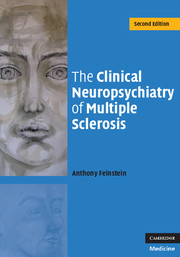Book contents
- Frontmatter
- Contents
- Acknowledgement
- Foreword
- 1 Multiple sclerosis: diagnosis and definitions
- 2 Depression: prevalence, symptoms, diagnosis and clinical correlates
- 3 Depression: etiology and treatment
- 4 Multiple sclerosis, bipolar affective disorder and euphoria
- 5 Multiple sclerosis and pseudobulbar affect
- 6 Multiple sclerosis and psychosis
- 7 Cognitive impairment in multiple sclerosis
- 8 The natural history of cognitive change in multiple sclerosis
- 9 Cognitive impairment in multiple sclerosis: detection, management and significance
- 10 Neuroimaging correlates of cognitive dysfunction
- 11 Multiple sclerosis, disease-modifying treatments and behavioral change
- 12 Multiple sclerosis: a subcortical, white matter dementia?
- Index
- Plate section
- References
11 - Multiple sclerosis, disease-modifying treatments and behavioral change
Published online by Cambridge University Press: 13 August 2009
- Frontmatter
- Contents
- Acknowledgement
- Foreword
- 1 Multiple sclerosis: diagnosis and definitions
- 2 Depression: prevalence, symptoms, diagnosis and clinical correlates
- 3 Depression: etiology and treatment
- 4 Multiple sclerosis, bipolar affective disorder and euphoria
- 5 Multiple sclerosis and pseudobulbar affect
- 6 Multiple sclerosis and psychosis
- 7 Cognitive impairment in multiple sclerosis
- 8 The natural history of cognitive change in multiple sclerosis
- 9 Cognitive impairment in multiple sclerosis: detection, management and significance
- 10 Neuroimaging correlates of cognitive dysfunction
- 11 Multiple sclerosis, disease-modifying treatments and behavioral change
- 12 Multiple sclerosis: a subcortical, white matter dementia?
- Index
- Plate section
- References
Summary
Introduction
There are currently four disease-modifying drugs available: interferon beta-1b, two forms of interferon beta-1a (Rebif, Avonex) and glatiramer acetate (Copaxone). All are injectable, but differ in their route and frequency of administration (Table 11.1). They are usually prescribed for patients with a relapsing–remitting disease course, where their chief benefit is a reduction in the frequency of relapse. A disparate finding is that whereas all treatments significantly reduce the lesion burden as visualized on MRI, this does not necessarily translate into the same degree of clinical improvement (O'Connor, 2000). This chapter will not review evidence pertaining to mechanism of action, therapeutic efficacy and general side effects of disease-modifying therapies. Instead, in keeping with the neurobehavioral content of this book, the focus will fall exclusively on the relationship between disease-modifying therapies on the one hand and depression and cognition on the other.
Disease-modifying drugs and depression
Interferon beta-1b
Concerns that treatment with the interferons may trigger depression first surfaced in the initial inteferon beta-1b trial (IFNB Multiple Sclerosis Study Group, 1993, 1995). Adding urgency to the observation was the fact that four subjects attempted, and one completed, suicide over the course of the five year study, in comparison with no such acts in the placebo group. While these differences were not found to be statistically significant, they were a harbinger of future concerns over a possible association between depression and the drug.
- Type
- Chapter
- Information
- The Clinical Neuropsychiatry of Multiple Sclerosis , pp. 214 - 231Publisher: Cambridge University PressPrint publication year: 2007



